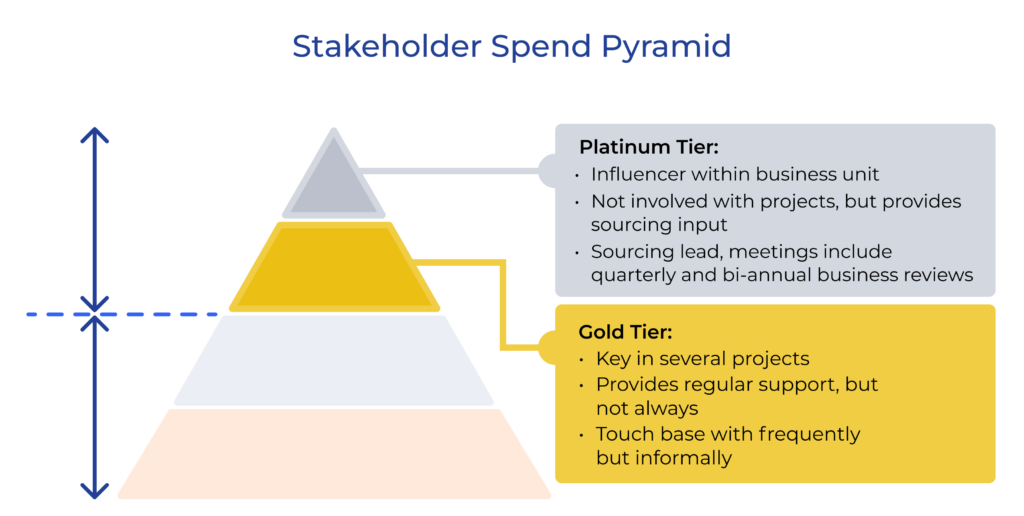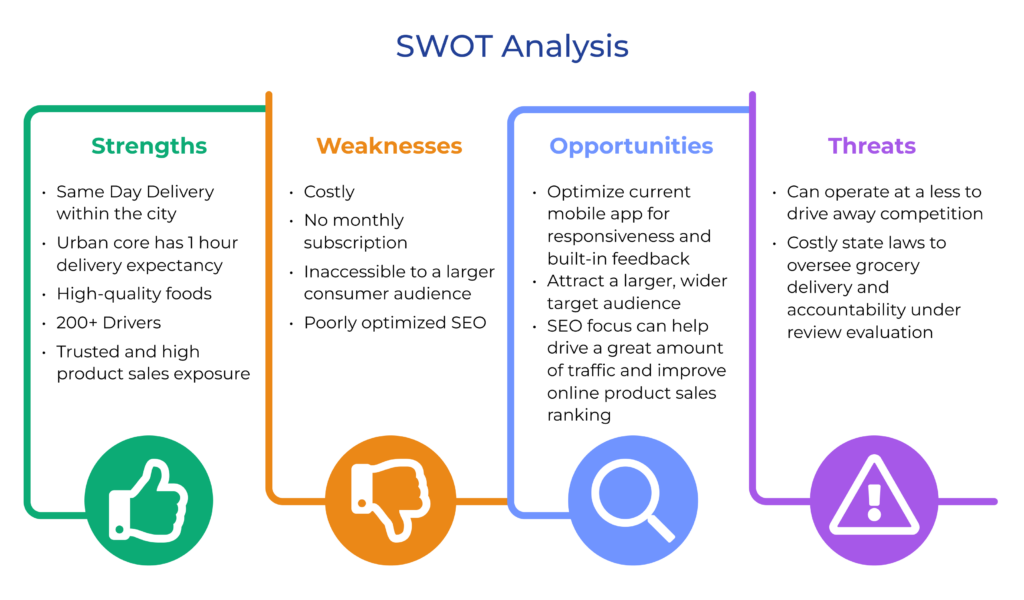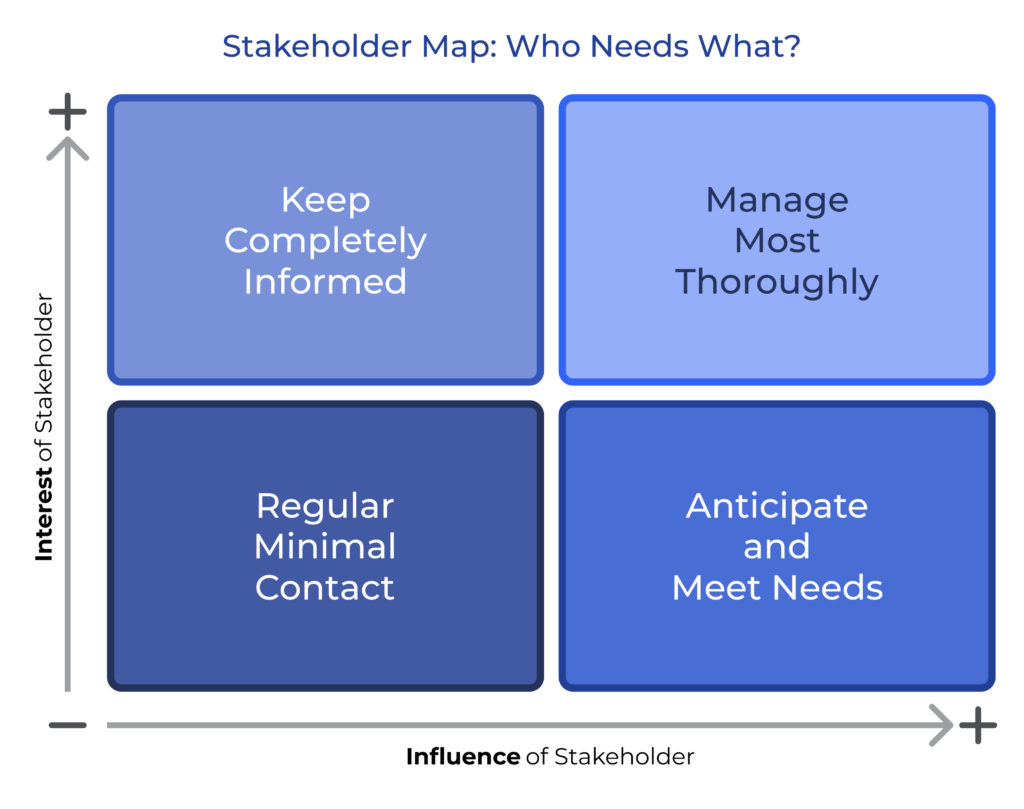Build Successful Partnerships with Internal Stakeholders
You work with many different internal and external stakeholders, from suppliers to finance teams, IT, and others. These partners are essential to your procurement team as they offer valuable input about their needs and goals.
Only by fully understanding their needs can you help them achieve their goals. And the earlier you engage with the stakeholder, the greater the value procurement can add.
By learning to engage and collaborate more effectively with internal stakeholders, you can ensure that your procurement strategies align with their business objectives. Plus, you’ll gain meaningful insights that lead to better sourcing decisions, more effective supplier and stakeholder management, fewer costs, and increased efficiency – a win-win for everyone!
“The number one goal of procurement is to enable business success,” says Conrad Smith, CEO of Graphite. “That means you must understand what will drive that success, and then you need to enable that.”
To do this, you must create an environment that facilitates seamless and proactive engagement with the procurement process.
According to Gartner®, sourcing, procurement and vendor management (SPVM) leaders must make it easy to engage procurement through a digital “front door.” This will enable the business to realize its objectives through the most appropriate and expeditious “procurement track.”*
Be a Trusted Business Advisor (Not an Order Taker)
When it comes to working with internal stakeholders, procurement professionals want to be seen as a trusted business partner rather than simply an order taker, a rival, or even worse, a deadweight.
“If you don’t partner with the business, they just see you as a back-office function that’s in the way. And therefore, you get involved less, there’s less engagement and fewer savings,” says David Hearn, a procurement expert with over 30 years in the industry. “To succeed in this role, you must focus on business success.” By thinking in terms of a business partnership, you have a vested interest in the shared outcome.
According to David Natoff, Founder of Blue Sphere Consulting, a boutique firm focusing on procurement, procurement teams must strike a balance between being a trusted partner and a guardian. However, this balancing act can be a challenge since leaning too far into the idea of partnership may lead to over-facilitation. At the same time, too much guardianship may lead to alienation and ignoring what value means to the primary stakeholders.
“The only way we can truly add value is if we act as business partners. That also means we have to be guardians of the company,” says Natoff. “It’s a fine balancing act that requires a diverse procurement team to provide the services our stakeholders require, while keeping the best interests of the company at heart.”
Master Stakeholder Engagement
The relationship between procurement and internal stakeholders is much like that between a doctor and a patient. The doctor asks questions to understand the problem and then suggests a course of action. That treatment plan may be challenging for the patient to adhere to, but the outcome could be significantly worse if not followed.
Similarly, you can act as a sounding board to help stakeholders navigate complex procurement decisions while offering advice to help them achieve their primary goal. If a patient doesn’t trust the doctor, will that individual follow the doctor’s advice? Likewise, will stakeholders follow your advice if they don’t trust you?
Strategies for Managing Internal Stakeholders
By effectively managing your relationships with internal stakeholders, says Hearn, you’ll “attain the holy grail of early involvement in your stakeholders’ decision-making, which in turn, yields maximum value and cost-saving for your company.”
Use the following strategies from seasoned procurement experts to earn trust and build better relationships with your stakeholders.
Focus On the Stakeholder and Value Will Follow
Value means different things to different people, so your procurement team must understand the value equation for each stakeholder you support. In other words, what’s important to each specific stakeholder, and how do they measure achievement?
“You need to see what the burning issues are in each of your different types of organizations,” says Natoff. “Understanding your stakeholder’s value equation is critical. If you’re not doing that, you won’t be successful.”
To determine the value equation, you have to think like that stakeholder. For example, what does value mean to someone who is in marketing? What about someone in Human Resources or IT?
Hearn recommends that each procurement team member—from senior leadership and management to sourcing professionals—get out there and engage with stakeholders. Go on road shows. Attend as many staff meetings as you can.
“Stop talking and start listening because through that—one, you’re going to get tons of feedback, and two, just the art of listening shows you care,” he advises. “So it’s having every level in the organization go out on listening exercises and engaging at all levels.”
Shift from a Cost-Saving to a Value-Driven Mindset
Value goes way beyond savings. “Procurement is transforming,” says Natoff. “The new goal is to drive sustainable value and permanent change to the procurement function.”
Too narrow a focus on cost-saving measures can inadvertently lead to behaviors that undermine overall business success and damage stakeholder relationships, warns Hearn. Conrad Smith, CEO of Graphite, agrees, “Procurement cost savings goals are one of the traps that can easily destroy that stakeholder relationship.”
Procurement must focus on stakeholders to achieve value, as opposed to focusing on cost to achieve savings. “If you help your stakeholders achieve their objectives, I guarantee value will follow—and that includes cost savings,” says Natoff. “And the only way you can do that is by engaging and communicating with stakeholders. Talk to them, listen to them, take the time to ask open questions, and understand what’s important to your your stakeholder.” Discover their pain points or challenges and how you can help solve those.
Determine Where the Biggest Opportunities Lie
The problem is that procurement doesn’t have unlimited resources. Not all stakeholders are created equally. So which projects should you prioritize since your team doesn’t have the time, money, or resources to work on 100 percent of them?
Natoff recommends looking at the spend data of your various stakeholder groups to see where the most significant opportunities lie and where you can add the most value. Use data to determine those with the highest spend, risk profile, and seniority.
Think about a stakeholder group, such as marketing. The different types of spend include advertising, events, and media buys. Look at the stakeholders involved. How big is the spend? What is the opportunity? Hearn recommends asking the head stakeholder of each major group what their biggest value opportunity is.
Prioritizing Stakeholders
From there, you can begin to prioritize your most critical internal stakeholders. Natoff suggests tiering stakeholders similar to how you rank suppliers in a spend pyramid. When prioritizing, it’s crucial to consider your stakeholders’ needs, impact, and alignment with your organization’s goals.
See the diagram of the Stakeholder Spend Pyramid below:

When looking at your stakeholder spend pyramid, how many represent 80 percent of the spend? How many represent the bottom 20 percent?
Once you’ve determined your top stakeholders, decide which services they value and focus on those rather than investing in services they don’t need. You’ll also want to invest more resources for those at the top of the pyramid.
Stakeholder Mapping
Another way to identify your most critical internal stakeholders is through stakeholder mapping. Like tiering, the purpose is to gain insights into the different project stakeholders to understand their perspectives, needs, and potential impact. Stakeholder mapping provides a structured framework to help you better assess potential risks, identify more opportunities, and develop effective strategies for planning and resource allocation throughout the lifecycle of a project.
There are different ways you can do this. One way is by conducting a SWOT analysis where you evaluate the strengths, weaknesses, opportunities, and potential threats the stakeholder faces.
See an example of a SWOT analysis below:

Another tool you can use is a stakeholder influence-interest grid. See the example below:

The horizontal axis represents the level of influence or power that stakeholders possess, ranging from low to high. The vertical axis represents the level of interest or involvement stakeholders have in the project or initiative, ranging from low to high.
Plot your stakeholders on the grid based on their level of direct influence and interest. Those with high influence and interest will be in the top-right quadrant, indicating that they are key stakeholders requiring significant attention and stakeholder engagement. Stakeholders with low influence and low direct interest will be placed in the bottom-left quadrant, indicating they require less focus.
Provide Data to Drive Informed Decisions
Of course, the final business decisions (and the business itself) always rest with the stakeholder. It’s up to you to provide valuable data and guidance that influences more informed decision-making. “Never forget, our whole reason for being is to make the business thrive,” Smith insists. “If we’re not helping them succeed, then we might as well not exist at all.”
For Natoff and many other companies, the top 200 suppliers represent massive spend. “Yet it surprised me how many of those top 200 [suppliers] procurement wasn’t influencing or managing for whatever reason,” says Natoff.
A classic example is employee benefits, which represent considerable spend. This is an area where procurement can provide data and advice to help stakeholders make more informed business decisions, such as going to market and reviewing other options.
Natoff says, “It’s about looking at your data and really prioritizing and focusing on the spend that’s going to add the most impact and value to your company’s success.” You may not change anything, but you can use the data you have to try to negotiate better terms or get more value for the business.
Once you understand their unique needs, you can tailor your approach to deliver value meaningfully to each stakeholder.
Measure Success & Demonstrate Value to Stakeholders
Your team’s achievements hinge on your ability to accurately measure the value your team provides and then communicate that impact to your internal stakeholders. Today, many procurement organizations implement Net Promoter Scores (NPS) as part of their core metrics.
But sending out a survey just once a year doesn’t generate the same high response rates as those sent upon the completion of a sourcing project in approximately six weeks. According to Natoff, these four- to five-question surveys typically get 70-80 percent response rates. Not only are they meaningful, but they help to develop and support the person running a particular sourcing project since scores are reported to senior management.
Another important metric that’s often missed is spend under management. This indicates the level of control and influence that a procurement team has over company spending and highlights the effectiveness of your procurement strategies. Although spend under management will never be 100 percent, it can come close to 80 percent with the right approach.
In addition, more procurement organizations are starting to implement ESG metrics, which consider the third-party impact on environmental practices, social responsibility, and corporate governance standards.
By consistently tracking and reporting on these and other metrics, you can demonstrate your team’s value, drive continuous improvement, and strengthen your strategic position within the organization.
Collaborate to Unlock Procurement Success
The success of your procurement team relies heavily on your ability to collaborate closely with internal stakeholders. Graphite offers deeper collaboration and transparency into all ongoing procurement projects for stakeholders and suppliers alike. Easily coordinate with internal stakeholders on their assigned tasks, follow up with suppliers on pending actions, and stay synced with InfoSec and Data Privacy teams to keep your procurement projects running smoothly.
By understanding the unique needs of each stakeholder, you can foster deeper trust, loyalty, and fruitful collaboration. That means actively listening to feedback to align procurement strategies with stakeholder objectives and deliver outcomes that generate tangible value, such as cost savings and quality improvements. You become a strategic and valued partner when you work together to address risks and develop solutions.
“Witnessing the magic when our team transcends boundaries and embraces a deep sense of partnership is truly inspiring,” says Smith. “When the lines between us blur, and we realize we’re in this journey together, the power of alignment becomes evident. It’s no longer about separate goals, but a unified purpose where everything converges to create something extraordinary.”
Ready to learn more?
Graphite Connect is a holistic supplier lifecycle and risk management tool. Explore how Graphite helps you collaborate more effectively with internal team members, suppliers, and stakeholders all in one place.
Request a Demo*Gartner, “Establish a Digital Front Door to Improve IT Procurement Engagement and Agility”, Oct 18, 2021. GARTNER is a registered trademark and service mark of Gartner, Inc. and/or its affiliates in the U.S. and internationally and is used herein with permission. All rights reserved.
